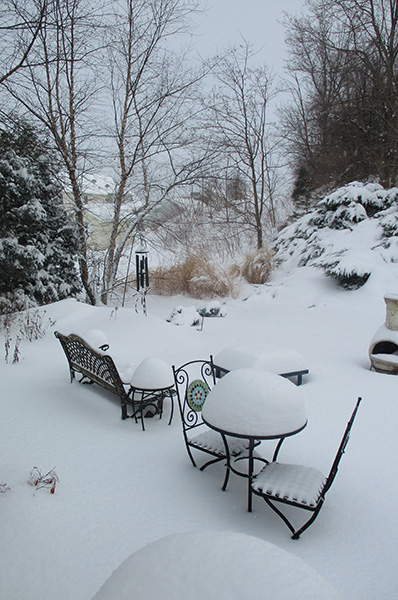 MENU
MENUWhat do you see when you look out your windows these wintery days? Piles of white snow with a few bare, brown/gray trees sticking out or colorful plants piercing through the snow banks? Even if you have the stark example now, you can have the colorful option at this time next year. But now’s the time to begin planning the transformation.

Ornamental grass (to the right behind the wind chimes in the photo) is the most common plant to consider for winter color and motion. It turns a tan color in the fall and stands tall above the snow. Many varieties have seedheads at the top that blow in the wind to add captivating movement to your landscape.Conifers are also popular. The conical shape and dark green color of pines, spruces and firs evoke images of a country forest scene, even in the suburbs. However, one conifer, the eastern larch (Larix laricinia), loses its needles in the winter. It’s the only native deciduous conifer, yet it provides year round interest from spring green to autumn gold to a beautiful winter silhouette.In winter, female hollies (Ilex sp.) show off their red berries just in time to be a symbol of the winter holidays. Be sure there’s a male plant nearby, in your yard or your neighbor’s, to provide the pollen needed to produce the berries. There are other plants that also produce berries in winter.Trees like dogwood (Cornus florida) have textured bark and red twigs that rise out of the snow to brightly dance in the wind against a backdrop of glistening white. Birch trees have interesting, exfoliating bark whose rough texture is in stark contrast to the smooth mounds of snow all around it. While white, or paper, birch (Betula papyrifera) has beautiful white bark, it also attracts deadly pests. River birch (Betula nigra) (to the left behind the wind chimes in the photo) is a good alternative. Its exfoliating yellow-brown bark may not be as spectacular as the paper birch but it doesn’t attract insects.Take lots of pictures of your yard now, especially the areas that could use some winter color and texture to make the cold, white snow more attractive. Use the images to see where new trees, shrubs or ornamentals would provide more winter interest. Then meet with one of our landscape designers to discuss your ideas. When we have a clear day with no snow, the designer may visit your property to see if the spots you’ve chosen are good places for your plant choices and if there are plants already growing there that were hidden by the snow.With all this information, our designer can then design your renovations and present them to you for approval. Once approved, the designer can start the wheels turning to schedule installation first thing in spring.